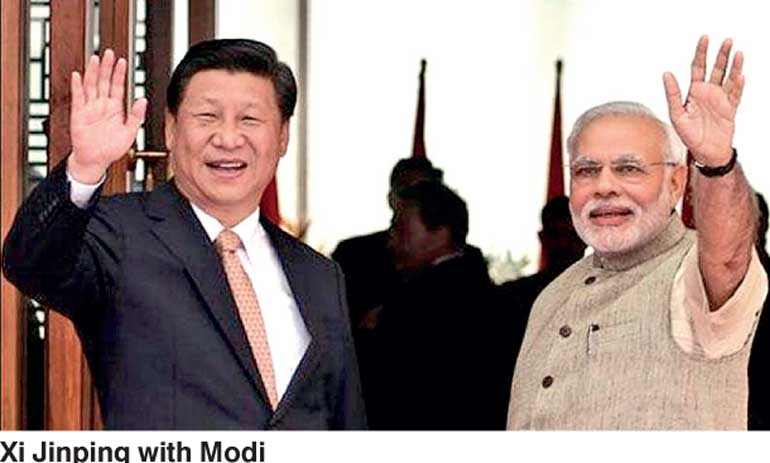Thursday Jan 08, 2026
Thursday Jan 08, 2026
Saturday, 10 March 2018 01:00 - - {{hitsCtrl.values.hits}}

After going through a tumultuous phase in 2017, relations between India and China now appear to be thawing with some tentative and yet significant steps being taken by the two countries to arrive at a détente if not a “solution” per se.
However, basic issues such as the 70-year border dispute, India’s concern over China’s economic and strategic intrusions into its sphere of influence in South Asia, China’s support to terror-sponsor Pakistan and fears about allowing Chinese investments in India remain. And these are not likely to be solved to mutual satisfaction in the foreseeable future.
But war, or a total breakdown of relations, or even a marked exacerbation of the conflict, are ruled out. Problems are likely to be sorted out diplomatically and through economic cooperation.
In 2017, a series of disputes marred relations between the two countries. The 72-day military standoff at the border in Doklam beginning between June and August had threatened to take the two countries to war as in 1962. If Doklam was taken by China, the gateway to the Indian State of West Bengal would have been opened to Chinese troops. And India would have been de-linked from its ally, Bhutan, which would have been added to China’ sphere of influence.
In January 2018, Chinese troops with road building equipment had crossed 200 meters into Indian territory in Arunachal Pradesh — an Indian state that China claims in its entirety as “South Tibet.”
China had been aggressive at the political level also. It opposed, tooth and nail, India’s bid to be a member of the Nuclear Suppliers Group (NSG). It blocked, on technical grounds, India’s efforts to get the UN to designate as a “global terrorist” the dreaded Pakistan-based Masood Azhar, chief of Jaish-e-Mohammed (JeM).
On its part, India openly opposed China’s ambitious Belt and Road Initiative (BRI), a pet project of President Xi Jinping. It boycotted an international conference in China on BRI even though more anti-China countries like US and Japan attended it. India joined the “Quad”, an Indo-Pacific strategic alliance comprising US, Australia and Japan, irritating China, which saw in it a global anti-China “gang up”.
Incurring China’s displeasure, Indian leaders, including Prime Minister Narendra Modi, visited Arunachal Pradesh an Indian border state which China claims is part of “South Tibet.” India is holding the mega naval exercise “Milan 2018” from March 6 to 13 with the participation of at least 16 countries including Australia and Malaysia. China thinks that the exercise aims to show China that India has a “strong influence” in the Indian Ocean.
Denouement not surprising
However, the peaceful denouement of the Doklam, Arunachal standoffs and previous standoffs in Ladakh, indicated that behind all the military sabre rattling and political posturing, neither side wanted to go to war. In every case, measured military movements on the part of China had been matched by India’s determination to stand its ground using the minimum military force.
According to Jeff M.Smith, South Asia Research Fellow at the Heritage Foundation, Chinese border incursions are essentially meant to convey a political message not to grab territory as such.
“They are designed to embarrass India’s leadership and to show the Indian public and the world, that China can operate at the border with impunity while underscoring Prime Narendra Modi’s inability to secure India’s sovereign borders,” Smith said.
India-China watchers would not have been surprised by the denouement of the above mentioned crises, given the fact that such situations had arisen before only to end in a sort of détente. For this, thanks must go to the “Border Peace and Tranquility Agreement”, painstakingly worked out by top Indian diplomat Shivshankar Menon and his Chinese interlocutors way back in 1993.
Encouraging signs
Following the rather traumatic Doklam episode, there have been some encouraging signs of improvement in bilateral ties. The new Indian Foreign Secretary Vijay Gokhale, has ushered a new era. A Mandarin Speaking China expert and a former Ambassador to China, Gokhale went to Beijing for a dialogue with the key Chinese interlocutor on security matters, State Councilor Yang Jiechi.
The cordiality witnessed at the meeting made even the hawkish Chinese Communist party publication Global Times gush optimistically. It said that the two sides had “agreed to deepen strategic communication, beef up mutually beneficial cooperation and properly settle sensitive issues, based on the consensus reached by leaders of the two countries.”
The Indian Embassy’s statement was equally sanguine about the meeting. It said that the two sides “noted the need to build on the convergences between India and China and address differences on the basis of mutual respect and sensitivity to each other’s concerns, interests and aspirations. Both sides underlined that as two major countries, sound development of relations between India and China is a factor of stability in the world today.”
Pakistan slightly sidelined
In a significant step away from the normal policy of supporting Pakistan blindly, China agreed to put Pakistan on the “Financial Action Task Force (FATF) terror financing grey list.”
When China took over the Vice Presidency of FATF with New Delhi’s support, India promptly congratulated it. The Indian External Affairs Ministry spokesperson tweeted congratulations along with the hope that “China would uphold and support the objectives and standards of FATF in a balanced, objective, impartial and holistic way.”
Many suspect that India and China had struck a deal on the FATF as China is also worried about unbridled Jehadi and Baloch terrorism in Pakistan. These terrorists could target China’s ambitious China-Pakistan Economic Corridor (CPEC) project there. Perhaps by listing Pakistan China was also telling Pakistan to control terrorists on its soil a measure that would immensely benefit India which has been a victim of Pakistan-based terrorists.
Chinese Foreign Minister Wang Yi visited New Delhi in December 2015 and met his counterpart Sushma Swaraj during the 15th Meeting of the Foreign Ministers of China, Russia and India. “Being anti-India is not in China’s interests and Beijing does not want Nepal, Sri Lanka and Maldives to adopt an attitude of exclusion toward India. In fact, all sides should work together to promote development in the region,” observed the Chinese Communist party’s publication Global Times.
The journal went on to say: “Vijay Gokhale’s visit shows that the two governments have prepared to manage differences seriously, enhance communication and reduce mistrust, preventing to turn India’s own imaginary threats from turning into conflicts. The Shanghai Cooperation Organization Summit to be held in Qingdao,  East China’s Shandong Province this June, will give Chinese and Indian leaders an opportunity to communicate face to face.”
East China’s Shandong Province this June, will give Chinese and Indian leaders an opportunity to communicate face to face.”
While Western analysts like Alyssa Ayres, a fellow at the Council on Foreign Relations who had served in the South and Central Asia Bureau of the State Department, predict that India and China will have a ‘Cold War-like’ relationship, Global Times thinks otherwise.
“Though Sino-Indian ties are becoming increasingly complicated, it is impossible for them to become cold war-like as it goes against the interests of both countries. Top leaders of the countries have a consistent assessment of ties. Chinese President Xi Jinping and Indian Prime Minister Narendra Modi agreed during the BRICS Summit in Xiamen, that China and India should see each other as development opportunities rather than threats.”
“In December, China’s State Councilor Yang Jiechi traveled to India to attend the 20th Special Representatives’ Meeting on China-India Boundary Questions and Chinese Foreign Minister Wang Yi attended the 15th meeting of Foreign Ministers of China, Russia and India in New Delhi, All these show that bilateral relations are stabilising and on the upswing,” Global Times said. “Beijing has attached great importance to diplomacy with New Delhi. Xi and Modi have met on varied occasions. Modi repeatedly said that India has always paid attention to its relations with China and is willing to strengthen cooperation with Beijing to promote sound and stable development. Frequent Sino-Indian high-level summits and the consensus reached at them can be regarded as cornerstones of the future stability of relations,” the Communist party publication said.
“There are unavoidable bumps between neighbors, but no fundamental contradictions exist between China and India. Almost all problems and disputes between the two sides in recent years are technical problems rather than fundamental strategic differences,” Global Times said.
India and China came close to armed conflict in the Maldives when former Maldivian President Mohamed Nasheed called for an Indian military intervention and China allegedly sent a fleet to the Eastern Indian Ocean to back beleaguered Maldivian President Abdulla Yameen. But New Delhi had no plans to intervene militarily and Indian officials denied any threatening Chinese naval movement.
India is concerned about China’s growing economic clout in Sri Lanka, Bangladesh, Nepal and Maldives becoming a strategic threat to it, but it is not willing to force the concerned governments to change their China policy so long as India’s security concerns and economic interests are given due weightage.
According Alyssa Ayers, India will not follow US’s China policy in toto. “I think India is going to be highly unlikely to be enlisted in something framed as a US-led effort to contain China. That is not what India seeks to do. It seeks to defend its own interests,” she said.
“India has been a big supporter of global norms, of freedom of navigation. But it also partners with China in many arenas. In the Asian Infrastructure Investment Bank (AIIB), India is the number two capital contributor,” she noted.
The BRICS organisation with India and China in it is a real institution, Ayers said and added that India is very active in BRICS which has created its own development bank. India became a member of the Shanghai Cooperation Organization.
And there is peace on the border. On 5 March, India’s Defense Minister Nirmala Sitharman, told parliament that “post disengagement from the face-off in 2017, troops of both sides have redeployed themselves away from their respective positions at the face-off site. The strength of both sides have been reduced.”
Sitharaman also said that border issues are being “regularly taken up with the Chinese side through diplomatic and border personnel meetings.’
Most recently, in order not to irk China, New Delhi asked the Tibetan government-in-exile in India to cancel its two main events in New Delhi, planned to mark the Dalai Lama’s 60 years in exile in India. This came in the wake of a note sent by the government last fortnight asking senior leaders and government functionaries to stay away from the events.
In its note, the government had underlined that it is a “very sensitive time for India’s relations with China.”